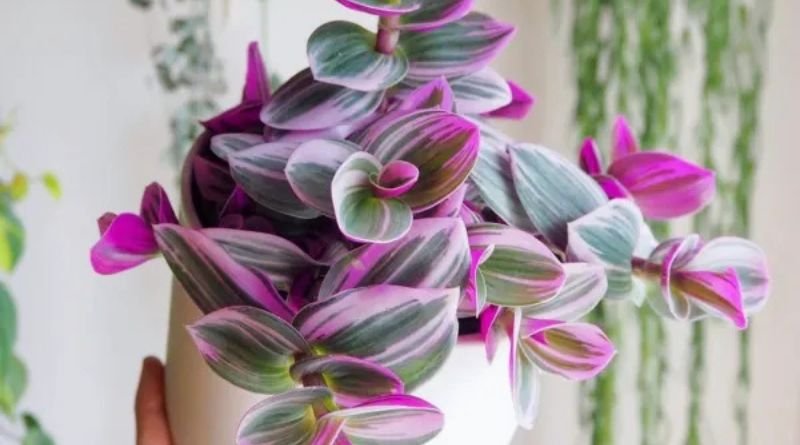The Wandering Jew plant (also known by its scientific name Tradescantia), with its vibrant foliage and trailing growth, has long been a popular choice for indoor gardeners. Renowned for its stunning colors and adaptability, the Wandering Jew is relatively easy to care for, making it an excellent choice for both beginners and seasoned plant lovers alike. Whether you’re a green thumb or just beginning your plant journey, knowing how to care for a Wandering Jew plant can help you enjoy its beauty for years to come.
In this comprehensive guide, we’ll cover everything you need to know about Wandering Jew plant care, including its light and water requirements, soil preferences, temperature, pruning, and common issues. Let’s dive into how you can create the ideal environment for this attractive and versatile plant.
Table of Contents
1. What is the Wandering Jew Plant?
The Wandering Jew is a member of the Tradescantia family and is native to the Americas. It’s most famous for its striking foliage, which typically includes a mix of purple, green, and silver stripes, although the colors can vary depending on the variety. There are several types of Wandering Jew plants, including Tradescantia zebrina (the most common variety), Tradescantia fluminensis, and Tradescantia pallida, each with unique color patterns.
This plant is known for its fast-growing, sprawling nature. It typically features elongated stems that trail and spread, making it an excellent choice for hanging baskets, window boxes, or as a ground cover. Its hardiness and ease of care have made it a favorite for houseplant enthusiasts.
2. Light Requirements
The Wandering Jew plant thrives in bright, indirect light. While it can tolerate some direct sunlight, too much can scorch its delicate leaves. Ideally, place your Wandering Jew plant near a window where it will receive ample light but is shielded from harsh rays, especially during the hottest part of the day.
If the plant is placed in low light conditions, it may still survive, but the colors in its leaves might dull, and its growth may slow. If you notice your plant becoming leggy or losing its vibrancy, it’s a sign that it may not be getting enough light.
Tip: If you can, rotate your Wandering Jew occasionally to ensure that all sides receive equal exposure to light, which promotes even growth and keeps the plant balanced.
3. Watering and Humidity
The Wandering Jew prefers a consistently moist environment but does not like to sit in water. Overwatering can lead to root rot, a common issue with this plant. The key is to allow the top inch of the soil to dry out before watering again. During the warmer months when the plant is actively growing, it may need watering more frequently, while in the winter, watering can be reduced as the plant enters a period of dormancy.
How to Water:
- Check the soil moisture: Stick your finger about an inch into the soil. If it feels dry, it’s time to water. If it still feels damp, wait another day or two.
- Water thoroughly: When you water, make sure to water deeply, ensuring that the water reaches the roots. Allow excess water to drain out of the bottom of the pot to avoid waterlogging.
- Humidity needs: The Wandering Jew plant enjoys higher humidity but is fairly tolerant of average indoor humidity levels. If you live in a particularly dry climate, you might want to increase the humidity around your plant. You can do this by placing a humidifier nearby, misting the leaves occasionally, or placing the pot on a tray filled with pebbles and water.
4. Temperature Preferences
The Wandering Jew plant thrives in temperatures between 60°F to 80°F (15°C to 27°C). It’s best to keep your plant away from cold drafts or direct exposure to air conditioners and heaters, as sudden temperature fluctuations can stress the plant.
In general, this plant does well in typical indoor temperatures. During the colder months, try to keep the plant in a warm room, as freezing temperatures can cause it to die back.
5. Soil and Potting
The Wandering Jew plant thrives in a well-draining soil mix. A standard potting mix with added perlite or sand for drainage is ideal. Avoid heavy soils that retain too much moisture, as this can cause the roots to rot. It’s also essential to plant it in a container with drainage holes to prevent water from accumulating at the bottom.
If your plant becomes root-bound, consider repotting it into a slightly larger pot once a year. This helps the plant continue to grow and maintain its health. Be sure to choose a pot that is only a few inches larger in diameter than the current one; going too large can lead to overwatering problems.
Tip: When repotting, gently loosen the roots if they’re tangled and remove any dead or rotting sections to promote healthy growth.
6. Pruning and Maintenance
Regular pruning helps to keep your Wandering Jew plant looking its best. The plant’s fast-growing nature means it may require frequent trimming to maintain a tidy shape and prevent it from becoming too leggy. Here’s how to properly prune your plant:
- Trim back long, leggy stems: Use clean, sharp scissors or pruning shears to cut back any overgrown stems. Cutting just above a leaf node encourages new growth and keeps the plant dense.
- Pinch back tips: Pinching the growing tips of the plant encourages branching, resulting in a fuller appearance.
- Remove dead or yellowing leaves: Regularly inspect your plant for any leaves that are yellow or damaged and remove them promptly.
7. Fertilizing
The Wandering Jew plant is a light feeder but benefits from regular feeding during the growing season. Apply a balanced liquid fertilizer once a month from spring through early fall. In the winter, you can reduce fertilization or stop altogether, as the plant’s growth slows down during the colder months.
Tip: Always dilute the fertilizer to half-strength to avoid overfeeding, which can lead to leaf burn.
8. Propagating the Wandering Jew
One of the most appealing aspects of the Wandering Jew plant is how easily it can be propagated. The plant readily roots in water or soil, and you can propagate it by taking a stem cutting with at least one leaf node. Here’s how to propagate:
- Stem Cutting: Use clean, sharp scissors to snip a 3-4 inch stem cutting from the plant.
- Rooting in Water: Place the cutting in a jar of water, ensuring the node is submerged. Change the water every few days until roots appear, usually within 1-2 weeks.
- Rooting in Soil: Alternatively, plant the cutting directly into a small pot with moist, well-draining soil. Keep the soil moist and place the pot in a warm spot until the roots establish.
- Transplant: Once roots have developed, transplant the cutting into its permanent pot.
9. Common Problems and Troubleshooting
While Wandering Jew plants are relatively low-maintenance, they can encounter a few issues. Here are some common problems and how to solve them:
- Yellowing Leaves: This could be a sign of overwatering or insufficient light. Check the soil moisture and move the plant to a brighter spot if needed.
- Leggy Growth: If your plant’s stems are growing long without much foliage, it’s likely not getting enough light. Move the plant to a sunnier spot and trim back the leggy stems.
- Pests: Although rare, the Wandering Jew can attract pests like spider mites, aphids, and mealybugs. If you notice small, discolored spots on the leaves or a sticky residue, inspect the plant closely and treat it with insecticidal soap or neem oil.
- Brown Leaf Tips: This can be a sign of low humidity or over-fertilization. Ensure that your plant has adequate humidity and avoid excessive feeding.
FAQs About Wandering Jew Plant Care
1. Can I grow a Wandering Jew outside?
Yes! In USDA hardiness zones 9-11, Wandering Jew plants can be grown outdoors as ground cover or in hanging baskets. However, they should be protected from frost.
2. Why are the leaves on my Wandering Jew turning brown?
Brown leaves can be a sign of inconsistent watering, low humidity, or exposure to direct sunlight. Adjust your care routine by ensuring the plant has proper light, moisture, and humidity.
3. Is the Wandering Jew plant toxic to pets?
Yes, the Wandering Jew plant is toxic to cats and dogs if ingested. Keep it out of reach of pets to avoid potential health issues.
4. How fast does a Wandering Jew grow?
The Wandering Jew plant is a fast grower, with stems that can grow up to several feet in a year under ideal conditions. Regular pruning helps manage its growth.
5. How often should I repot my Wandering Jew?
Repotting should be done once a year or when the plant becomes root-bound. Choose a pot that’s 1-2 inches larger than the current one to provide ample space for growth.
Conclusion
The Wandering Jew plant is a stunning addition to any home, offering vibrant colors, fast growth, and minimal care requirements. By providing the right light, water, and soil conditions, you can enjoy a healthy and thriving plant year
-round. Whether you’re growing it as a hanging basket, ground cover, or in a decorative pot, the Wandering Jew will continue to captivate with its beauty and effortless charm.


